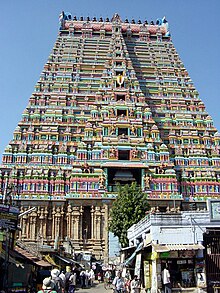| Tirupalliyeḻuchi | |
|---|---|
| ← TirumālaiAmalanatipiran → | |
 Gopuram of the Ranganathaswamy Temple, Srirangam. Gopuram of the Ranganathaswamy Temple, Srirangam. | |
| Information | |
| Religion | Hinduism |
| Author | Tondaradippodi Alvar |
| Language | Tamil |
| Period | 9th–10th century CE |
| Verses | 10 |
The Tirupalliyeḻuchi (Tamil: திருப்பள்ளியெழுச்சி, romanized: Tirupaḷḷiyeḻucci, lit. 'the rousing of the sacred temple'), also rendered Tirupalli Eluchi, is a work of Tamil Hindu literature written by Tondaradippodi Alvar, comprising ten hymns. The title of this work is a reference to the act of Suprabhatam, a Sri Vaishnava ritual, the prayer at dawn that is believed to rouse Vishnu from his sleep and protect the world. The work is part of the compendium of the hymns of the Alvars, known as the Nalayira Divya Prabandham.
Tirupalliyeḻuchi, as a ritual, is performed prominently throughout the month of Margaḻi in the Vishnu temples of South India.
Hymns
The first hymn of this work begins as follows:
The sun has risen over the Eastern horizon destroying the darkness. Flowers have blossomed in great numbers. Found rushing towards Your sanctum are Kings and devatas (gods). The elephants on whose back they arrived, and kettledrums are making thundering sounds resembling roar of the sea. Please do wake up, O Lord of Arangam!
— Tirupalliyeḻuchi, Hymn 1
The fourth hymn makes references to the avataras of Rama and Krishna:
The sounds of the cowherd's flute and the bells of the cattle blend and spread everywhere. In the fields the bumble bees are swarming. O Lord of celestials who destroyed the Lanka clan with a bow and stood guard over the seers’ sacrifice! O Lord, Ayodhya’s coronated king! O Lord of Arangam, my Liege, pray wake up.
— Tirupalliyeḻuchi, Hymn 4
See also
References
- Ramaswamy, Sumathi (1997-11-20). Passions of the Tongue: Language Devotion in Tamil India, 1891–1970. University of California Press. p. 95. ISBN 978-0-520-91879-5.
- Rengarajan, T. (1999). Glossary of Hinduism. Oxford & IBH Publishing Company. p. 20. ISBN 978-81-204-1348-1.
- Jones, Constance; Ryan, James D. (2006). Encyclopedia of Hinduism. Infobase Publishing. p. 23. ISBN 978-0-8160-7564-5.
- Nayar, Nancy Ann (1992). Poetry as Theology: The Śrīvaiṣṇava Stotra in the Age of Rāmānuja. Otto Harrassowitz Verlag. p. 143. ISBN 978-3-447-03255-1.
- "Mudalayiram" - K. R. KrishnaSwami [4000 Divya Prabandham Series, Vol. 4, 1st edition, July 2009, A & K Prakashana].
- Good, Anthony (2001). "Multiple meanings in South Indian temple worship". Culture and Religion. 2 (2): 239–260. doi:10.1080/01438300108567177. S2CID 144095192.
- "Mudalayiram" - K. R. KrishnaSwami [4000 Divya Prabandham Series, Vol. 4, 1st edition, July 2009, A & K Prakashana]. pp. 53–54.
- Makarand Joshi. The Sacred Book Of Four Thousand 01 Nalayira Divya Prabandham Sri Rama Bharati 2000. p. 184.
- Rao, Ajay K. (2014-10-03). Re-figuring the Ramayana as Theology: A History of Reception in Premodern India. Routledge. p. 107. ISBN 978-1-134-07735-9.
